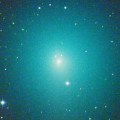
|
Now it is very bright as 6.0 mag (Apr. 7, Juan Jose Gonzalez). Now it is approaching to Earth down to 0.14 a.u. It is observable in excellent condition in the Northern Hemisphere. In the Southern Hemisphere, it is not be observable for about one month from late March to late April.
Date(TT) R.A. (2000) Decl. Delta r Elong. m1 Best Time(A, h)
Apr. 15 16 55.87 56 46.1 0.155 1.045 101 5.5 3:21 (180, -2)
Apr. 22 17 42.02 48 56.6 0.170 1.053 101 5.8 3:41 (180, 6)
|

|
Outburst occured on Apr. 4, and it brightened by 2 mag. Now it is very bright as 6.2 mag (Apr. 7, Juan Jose Gonzalez). It stays observable for a long time after this. But it locates low in the Northern Hemisphere.
Date(TT) R.A. (2000) Decl. Delta r Elong. m1 Best Time(A, h)
Apr. 15 21 39.78 -10 8.3 1.181 1.123 61 7.4 4:59 (251, 41)
Apr. 22 22 13.86 -6 31.6 1.180 1.085 58 7.2 5:04 (248, 38)
|
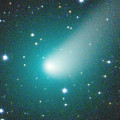
|
Now it is 9.2 mag (Apr. 7, Juan Jose Gonzalez). It was expected to brighten up to 6-7 mag from April to July. But it is fainter than predicted recently. In the Northern Hemisphere, it stays observable in excellent condition until June. In the Southern Hemisphere, it stays extremely low for a while.
Date(TT) R.A. (2000) Decl. Delta r Elong. m1 Best Time(A, h)
Apr. 15 16 20.69 47 6.1 1.179 1.813 112 7.9 2:49 (180, 8)
Apr. 22 16 10.71 46 10.5 1.103 1.775 114 7.7 2:11 (180, 9)
|

|
It brightened very rapidly, and brightened up to 6.3 mag (Apr. 2, Terry Lovejoy). However, it turned to be fading after Apr. 9. Now it is 9.2 mag (Apr. 14, Ken-ichi Kadota). In the Northern Hemisphere, it stays observable in the morning sky until late April. In the Southern Hemisphere, it is already unobservable.
Date(TT) R.A. (2000) Decl. Delta r Elong. m1 Best Time(A, h)
Apr. 15 0 4.94 34 47.4 0.851 0.533 32 9.2 4:59 (237,-14)
Apr. 22 1 5.10 36 53.3 1.061 0.495 27 11.0 5:04 (238,-20)
|
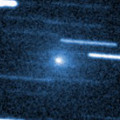
|
Now it is 10.9 mag (Apr. 5, Chris Wyatt). It stays 10-11 mag until May. In the Southern Hemisphere, it stays observable for a long time, but it stays low. It will not be observable soon in the Northern Hemisphere. Juan Jose Gonzalez reported it is very bright as 7.9 mag on Apr. 7.
Date(TT) R.A. (2000) Decl. Delta r Elong. m1 Best Time(A, h)
Apr. 15 23 7.28 -2 22.0 1.449 0.905 38 10.7 4:59 (259, 19)
Apr. 22 23 39.71 -0 46.0 1.508 0.926 36 10.9 5:04 (258, 18)
|

|
It has not been observed yet in this apparition. The condition of this apparition is worst. It will brighten up to 10 mag in spring, but not observable at all.
Date(TT) R.A. (2000) Decl. Delta r Elong. m1 Best Time(A, h)
Apr. 15 1 50.83 12 3.7 2.064 1.069 5 11.3 19:00 ( 94,-15)
Apr. 22 2 20.71 13 38.1 2.062 1.066 5 11.1 18:52 ( 97,-14)
|
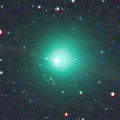
|
Now it is fading rapidly. It has already faded down to 9.8 mag (Apr. 5, Chris Wyatt). In the Southern Hemisphere, it stays observable after this while the comet will be fading. In the Northern Hemisphere, it stays unobservable until May when it becomes fainter than 14 mag.
Date(TT) R.A. (2000) Decl. Delta r Elong. m1 Best Time(A, h)
Apr. 15 22 38.80 -17 57.8 1.065 0.892 51 11.7 4:59 (270, 33)
Apr. 22 22 43.52 -17 38.7 1.116 1.011 56 12.6 5:04 (265, 38)
|
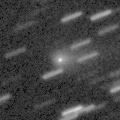
|
Now it is 15.0 mag (Apr. 2, Kunihiro Shima). It is expected to brighten up to 10 mag in summer. But actually, it is much fainter than this ephemeris recently. It will be observable in excellent condition in the Southern Hemisphere. It locates low in the Northern Hemisphere.
Date(TT) R.A. (2000) Decl. Delta r Elong. m1 Best Time(A, h)
Apr. 15 16 32.47 -17 16.8 0.877 1.742 135 12.3 3:00 (180, 72)
Apr. 22 16 37.17 -18 22.2 0.812 1.716 141 12.0 2:38 (180, 73)
|

|
Now it is 11.9 mag (Apr. 1, Andrew Pearce). Bright new fragment BT was discovered on Feb. 10. Now the fragment BT is fainter than the primary component. In the Southern Hemisphere, it stays observable for a long time after this. In the Northern Hemisphere, it is not observable temporarily until mid June.
Date(TT) R.A. (2000) Decl. Delta r Elong. m1 Best Time(A, h)
Apr. 15 23 11.50 -11 57.1 1.581 1.058 41 12.8 4:59 (269, 23)
Apr. 22 23 36.43 -9 56.9 1.625 1.100 41 13.1 5:04 (266, 24)
|

|
Now it is 15.7 mag (Apr. 1, Kunihiro Shima). It locates high in the Southern Hemisphere.
Date(TT) R.A. (2000) Decl. Delta r Elong. m1 Best Time(A, h)
Apr. 15 21 27.72 -15 17.6 6.195 5.851 65 13.7 4:59 (255, 46)
Apr. 22 21 31.11 -14 56.7 6.090 5.850 71 13.7 5:04 (248, 51)
|
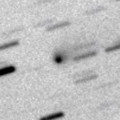
|
Now it is 15.8 mag (Apr. 2, Kunihiro Shima). It will brighten up to 14 mag from spring to summer. It locates somewhat low in the Northern Hemisphere. The perihelion distance increased from 2.4 a.u. to 2.9 a.u. in this apparition. So it will not be bright as before.
Date(TT) R.A. (2000) Decl. Delta r Elong. m1 Best Time(A, h)
Apr. 15 16 30.76 -20 30.4 2.250 3.051 135 14.4 2:59 (180, 76)
Apr. 22 16 28.95 -20 43.1 2.177 3.041 143 14.3 2:30 (180, 76)
|

|
Now it is bright as 14.4 mag (Jan. 14, Thomas Lehmann). It is not observable now in the Northern Hemisphere. It will be unobservable temporarily in May also in the Southern Hemisphere. It will be getting higher gradually in the morning sky after summer. Then it will be observable at 11 mag for a long time from 2017 autumn to 2018 winter.
Date(TT) R.A. (2000) Decl. Delta r Elong. m1 Best Time(A, h)
Apr. 15 3 23.65 -17 1.7 5.414 4.668 38 14.4 19:00 ( 83, 20)
Apr. 22 3 29.32 -15 52.4 5.393 4.616 35 14.3 18:52 ( 82, 16)
|
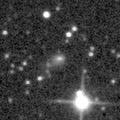
|
Now it is 15.9 mag (Mar. 30, Kunihiro Shima). It will be observable at 13 mag for a long time from 2017 to 2018.
Date(TT) R.A. (2000) Decl. Delta r Elong. m1 Best Time(A, h)
Apr. 15 19 6.05 8 19.0 4.410 4.608 95 14.7 4:59 (192, 46)
Apr. 22 19 2.42 9 47.8 4.267 4.574 101 14.6 5:03 (180, 45)
|

|
It has not been observed yet in this apparition. It will brighten up to 12 mag in summer. It will be observable in excellent condition in the Southern Hemisphere. It locates somewhat low in the Northern Hemisphere.
Date(TT) R.A. (2000) Decl. Delta r Elong. m1 Best Time(A, h)
Apr. 15 18 55.16 -33 24.1 1.886 2.328 103 14.9 4:59 (254, 85)
Apr. 22 19 3.82 -33 24.0 1.785 2.303 107 14.6 5:04 (180, 88)
|

|
Now it is 15.6 mag (Feb. 15, Alexander Baransky). It will brighten up to 12-13 mag and will be observable in good condition in summer. Now it is not observable. It will appear in the morning sky in May.
Date(TT) R.A. (2000) Decl. Delta r Elong. m1 Best Time(A, h)
Apr. 15 0 19.44 14 3.9 3.995 3.060 18 14.8 4:59 (257, -6)
Apr. 22 0 20.70 14 18.2 3.919 3.028 23 14.7 5:04 (252, 0)
|
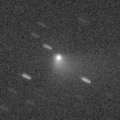
|
Small outburst occured in mid March. Now it is 14.6 mag (Mar. 26, Sandor Szabo). It is observable in excellent condition in the Northern Hemisphere. It stays low in the Southern Hemisphere.
Date(TT) R.A. (2000) Decl. Delta r Elong. m1 Best Time(A, h)
Apr. 15 11 30.92 30 5.1 1.858 2.624 130 15.0 21:56 (180, 25)
Apr. 22 11 29.73 29 0.8 1.933 2.645 125 15.2 21:27 (180, 26)
|

|
Appearing in the morning sky. In the Northern Hemisphere, it will brighten up to 14 mag from summer to next winter, and it will be observable in excellent condition. In the Southern Hemisphere, it will be observable in the very low sky only from May to June.
Date(TT) R.A. (2000) Decl. Delta r Elong. m1 Best Time(A, h)
Apr. 15 23 56.88 16 42.5 4.412 3.522 24 15.2 4:59 (251, -3)
Apr. 22 0 2.12 18 34.8 4.343 3.495 28 15.1 5:04 (246, 1)
|
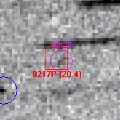
|
It will brighten rapidly, and it is expected to brighten up to 12 mag from July to September. In the Southern Hemisphere, it stays at the same altitude in the morning sky. In the Northern Hemisphere, it will be getting higher slowly.
Date(TT) R.A. (2000) Decl. Delta r Elong. m1 Best Time(A, h)
Apr. 15 22 14.42 -10 27.1 2.073 1.678 53 15.6 4:59 (258, 34)
Apr. 22 22 35.43 -9 8.3 1.982 1.625 54 15.3 5:04 (255, 35)
|

|
Now it is 15.6 mag (Mar. 6, Kunihiro Shima). Now it is not observable. But it will appear in the morning sky in June in the Southern Hemisphere, or in July in the Northern Hemisphere. Then it stays observable at 15.5 mag unil the end of 2017.
Date(TT) R.A. (2000) Decl. Delta r Elong. m1 Best Time(A, h)
Apr. 15 2 2.80 2 1.6 6.391 5.409 10 15.4 19:00 ( 87, -8)
Apr. 22 2 9.22 2 27.1 6.417 5.430 10 15.4 18:52 ( 86,-11)
|
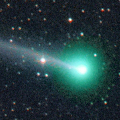
|
It approached to Earth down to 0.08 a.u. in mid February, and brightened up to 6.5 mag (Feb. 10, Danil Sidorko). Now it is fading rapidly. It has already faded down to 11.2 mag (Mar. 19, Osamu Miyazaki).
Date(TT) R.A. (2000) Decl. Delta r Elong. m1 Best Time(A, h)
Apr. 15 10 34.79 17 11.7 1.007 1.811 128 15.9 21:00 (180, 38)
Apr. 22 10 38.19 16 10.3 1.148 1.893 122 16.5 20:36 (180, 39)
|

|
Now it is 17.0 mag (Mar. 2, Thomas Lehmann). It is expected to brighten up to 9 mag in summer in 2018. In the Northern Hemisphere, it stays observable until 2018 summer while the comet will be brightening. In the Southern Hemisphere, it is hardly observable in 2017, but it will be observable in good condition in 2018.
Date(TT) R.A. (2000) Decl. Delta r Elong. m1 Best Time(A, h)
Apr. 15 19 12.14 50 16.7 5.390 5.410 85 16.0 4:59 (186, 4)
Apr. 22 19 10.67 51 0.6 5.294 5.354 87 15.9 5:04 (181, 4)
|

|
Now it is 15.7 mag (Mar. 26, Sandor Szabo). It stays 16-17 mag for a long time from 2016 to 2019. It stays near by the equator.
Date(TT) R.A. (2000) Decl. Delta r Elong. m1 Best Time(A, h)
Apr. 15 9 5.09 5 53.7 9.178 9.592 111 16.0 19:30 (180, 49)
Apr. 22 9 5.62 6 8.4 9.281 9.589 104 16.0 19:03 (180, 49)
|

|
It brightened up to 11 mag from spring to summer in 2016. Now it is 16.8 mag (Apr. 2, Kunihiro Shima). It will be observable at 16-17 mag in good condition from spring to summer.
Date(TT) R.A. (2000) Decl. Delta r Elong. m1 Best Time(A, h)
Apr. 15 20 18.58 -17 44.6 2.782 2.826 82 16.1 4:59 (241, 61)
Apr. 22 20 23.71 -17 27.3 2.723 2.866 87 16.1 5:04 (230, 65)
|

|
Now it is 17.3 mag (Mar. 3, T. Ikemura, H. Sato). It was observed at 16 mag from spring to summer in 2016. It will be observable at 16 mag also in 2017 from winter to spring.
Date(TT) R.A. (2000) Decl. Delta r Elong. m1 Best Time(A, h)
Apr. 15 18 26.08 9 50.3 3.051 3.441 104 16.2 4:54 (180, 45)
Apr. 22 18 27.44 11 56.3 3.003 3.465 109 16.2 4:27 (180, 43)
|

|
Now it is 16.6 mag (Mar. 30, Kunihiro Shima). It stays observable at 16 mag until June. It locates low in the Southern Hemisphere.
Date(TT) R.A. (2000) Decl. Delta r Elong. m1 Best Time(A, h)
Apr. 15 7 2.87 27 7.2 3.728 3.672 79 16.2 19:00 (158, 24)
Apr. 22 7 8.84 26 56.2 3.821 3.666 73 16.2 18:52 (155, 23)
|

|
It brightened up to 6.2 mag in June in 2016 (June 24, Marco Goiato). Now it is fading. But recently, it is bright as 15.6 mag (Apr. 2, Kunihiro Shima). In the Southern Hemisphee, it stays observable in excellent condition after this. It stays low in the Northern Hemisphere.
Date(TT) R.A. (2000) Decl. Delta r Elong. m1 Best Time(A, h)
Apr. 15 13 27.49 -31 48.3 3.660 4.604 157 16.4 23:51 (180, 87)
Apr. 22 13 16.80 -30 44.1 3.719 4.672 159 16.5 23:13 (180, 86)
|

|
It stayed bright 12 mag for a long time from autum in 2015 to summer in 2016. Now it is fading. It has already faded dwon to 16.2 mag (Apr. 1, Kunihiro Shima).
Date(TT) R.A. (2000) Decl. Delta r Elong. m1 Best Time(A, h)
Apr. 15 17 13.59 -9 12.9 4.106 4.759 125 16.6 3:42 (180, 64)
Apr. 22 17 8.95 -9 39.0 4.066 4.811 133 16.6 3:10 (180, 65)
|

|
Now it is 16.2 mag (Apr. 2, Kunihiro Shima). It stays 16.5 mag from 2016 to 2017. In the Northern Hemisphere, it stays observable in good condition for a long time. In the Southern Hemisphere, it will never be observable again.
Date(TT) R.A. (2000) Decl. Delta r Elong. m1 Best Time(A, h)
Apr. 15 19 2.56 53 38.2 6.282 6.303 86 16.6 4:59 (185, 1)
Apr. 22 19 3.68 55 6.8 6.269 6.310 87 16.6 5:03 (180, 0)
|
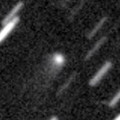
|
Now it is 16.2 mag (Mar. 26, Sandor Szabo). It stays 16 mag for a long time from 2017 to 2018.
Date(TT) R.A. (2000) Decl. Delta r Elong. m1 Best Time(A, h)
Apr. 15 8 17.86 6 40.2 5.317 5.578 99 16.6 19:00 (174, 48)
Apr. 22 8 16.50 7 41.8 5.424 5.563 92 16.6 18:52 (166, 46)
|

|
Now it is 17.3 mag (Mar. 6, iTelescope Observatory, Siding Spring). It will brighten up to 15.5 mag in summer. It will be observable in excellent condition in the Southern Hemisphere. In the Northern Hemisphere, it stays unobservable for some more time.
Date(TT) R.A. (2000) Decl. Delta r Elong. m1 Best Time(A, h)
Apr. 15 20 55.59 -44 43.8 2.608 2.670 82 16.8 4:59 (300, 61)
Apr. 22 21 8.25 -44 1.6 2.510 2.643 86 16.7 5:04 (300, 65)
|

|
It has not been recovered yet in this apparition. It will brighten rapidly, and it is expected to be observable at 15.5 mag in good condition from July to September.
Date(TT) R.A. (2000) Decl. Delta r Elong. m1 Best Time(A, h)
Apr. 15 22 54.52 -25 3.9 3.103 2.605 51 17.0 4:59 (279, 33)
Apr. 22 23 7.26 -23 54.9 3.031 2.593 55 16.9 5:04 (275, 37)
|
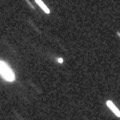
|
Now it is 16.2 mag (Mar. 30, Kunihiro Shima). It brightened rapidly, and became brighter than originally expected. It stays 16-17 mag until 2017. In the Northern Hemisphere, it stays observable in excellent condition for a long time. It is not observable in the Southern Hemisphere.
Date(TT) R.A. (2000) Decl. Delta r Elong. m1 Best Time(A, h)
Apr. 15 11 57.76 60 16.4 7.083 7.447 107 17.1 22:22 (180, -5)
Apr. 22 11 49.44 59 37.1 7.154 7.457 103 17.2 21:46 (180, -4)
|

|
It brightened up to 15 mag in early 2016. Now it is fading. It has already faded down to 17.1 mag (Mar. 3, K. Hills). In the Northern Hemisphere, it stays observable in good condition for a long time until autumn when the comet will be fainter than 18 mag. It will never be observable after this in the Southern Hemisphere.
Date(TT) R.A. (2000) Decl. Delta r Elong. m1 Best Time(A, h)
Apr. 15 14 38.72 72 7.7 6.406 6.612 97 17.2 1:07 (180,-17)
Apr. 22 14 27.53 71 50.9 6.464 6.643 95 17.3 0:28 (180,-17)
|

|
Now it is 17.0 mag (Mar. 13, E. Primucci). In the Southern Hemisphere, it is observable at 17 mag in good condition in spring. It stays extremely low in the Northern Hemisphere.
Date(TT) R.A. (2000) Decl. Delta r Elong. m1 Best Time(A, h)
Apr. 15 12 51.23 -43 18.3 5.074 5.925 145 17.3 23:16 ( 0, 82)
Apr. 22 12 47.92 -42 11.7 5.061 5.922 146 17.2 22:45 ( 0, 83)
|

|
It has not been observed since last April. Now it is fading. But it must be bright as 17 mag still now.
Date(TT) R.A. (2000) Decl. Delta r Elong. m1 Best Time(A, h)
Apr. 15 17 7.47 -17 59.8 2.590 3.296 127 17.2 3:36 (180, 73)
Apr. 22 17 4.34 -17 33.0 2.582 3.367 134 17.3 3:05 (180, 73)
|
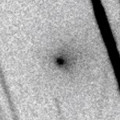
|
Small comet, but it approached to Sun down to 0.9 a.u., and to Earth down to 0.5 a.u. It brightened very rapidly, and brightened up to 10.7 mag in late February (Feb. 24, Juan Jose Gonzalez). It is fading very rapidly after that. It has already faded down to 18.7 mag (Mar. 29, Kunihiro Shima). It is observable in excellent condition in the Northern Hemisphere. In the Southern Hemisphere, it is not observable after this.
Date(TT) R.A. (2000) Decl. Delta r Elong. m1 Best Time(A, h)
Apr. 15 10 1.63 75 46.8 0.550 1.136 89 17.3 20:37 (180,-20)
Apr. 22 11 42.63 68 37.3 0.581 1.210 95 17.7 21:45 (180,-13)
|

|
Now it is 17.0 mag (Mar. 2, Kunihiro Shima). It is observable in excellent condition in the Northern Hemisphere. It locates low in the Southern Hemisphere.
Date(TT) R.A. (2000) Decl. Delta r Elong. m1 Best Time(A, h)
Apr. 15 7 12.11 30 23.1 3.595 3.574 80 17.4 19:00 (161, 22)
Apr. 22 7 19.20 29 54.0 3.705 3.589 75 17.4 18:52 (158, 21)
|
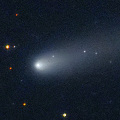
|
It brightened up to 11-12 mag from summer to autumn in last year. Now it is fading. It has already faded down to 16.0 mag (Mar. 30, Kunihiro Shima).
Date(TT) R.A. (2000) Decl. Delta r Elong. m1 Best Time(A, h)
Apr. 15 11 36.09 -20 29.1 1.766 2.682 149 17.4 22:01 (180, 75)
Apr. 22 11 33.23 -19 9.5 1.847 2.728 144 17.6 21:30 (180, 74)
|
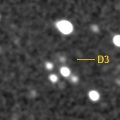
|
Now it is 17.1 mag (Mar. 7, iTelescope Observatory, Siding Spring). It is observable at 17.5 mag in good condition in spring. It locates somewhat low in the Northern Hemisphere.
Date(TT) R.A. (2000) Decl. Delta r Elong. m1 Best Time(A, h)
Apr. 15 12 29.66 -25 55.6 4.028 4.972 157 17.5 22:54 (180, 81)
Apr. 22 12 22.22 -24 3.5 4.047 4.971 154 17.5 22:19 (180, 79)
|

|
It will be observable at 17.5 mag in good condition from April to May.
Date(TT) R.A. (2000) Decl. Delta r Elong. m1 Best Time(A, h)
Apr. 15 17 51.82 -8 4.9 1.821 2.434 116 17.7 4:20 (180, 63)
Apr. 22 17 33.06 -9 31.7 1.718 2.461 127 17.6 3:34 (180, 64)
|
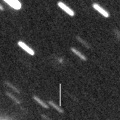
|
It stays at 14 mag for a long time from 2018 to 2019. In the Northern Hemisphere, it stays observable in good condition while the comet will be brightening gradually. In the Southern Hemisphere, it is not observable until 2018 October.
Date(TT) R.A. (2000) Decl. Delta r Elong. m1 Best Time(A, h)
Apr. 15 18 27.66 49 25.7 5.046 5.196 92 17.7 4:55 (180, 6)
Apr. 22 18 23.41 51 14.3 4.961 5.144 94 17.6 4:23 (180, 4)
|
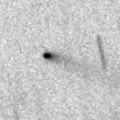
|
Now it is 18.0 mag (Mar. 28, Kunihiro Shima). It was observed at 17 mag in early 2016 and early 2017. It will be fainter than 18 mag in May. It is observable in good condition in the Northern Hemisphere. But it locates low in the Southern Hemisphere.
Date(TT) R.A. (2000) Decl. Delta r Elong. m1 Best Time(A, h)
Apr. 15 10 54.93 42 43.1 3.795 4.336 116 17.8 21:20 (180, 12)
Apr. 22 10 54.13 42 53.8 3.910 4.368 110 17.9 20:52 (180, 12)
|
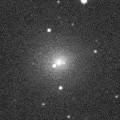
|
It brightened up to 11-12 mag in autumn. Now it is fading. It has already faded down to 16.9 mag (Mar. 3, T. Ikemura, H. Sato).
Date(TT) R.A. (2000) Decl. Delta r Elong. m1 Best Time(A, h)
Apr. 15 13 18.43 -12 60.0 1.682 2.683 175 17.8 23:42 (180, 68)
Apr. 22 13 12.41 -12 11.9 1.739 2.732 168 18.1 23:09 (180, 67)
|

|
Very far object. Outburst occured on Feb. 20, 2015, and it brightened up to 15 mag. Now it is 18.3 mag (Mar. 30, Kunihiro Shima). It is observable in excellent condition in the Southern Hemisphere. It locates low in the Northern Hemisphere.
Date(TT) R.A. (2000) Decl. Delta r Elong. m1 Best Time(A, h)
Apr. 15 14 36.35 -26 8.7 8.456 9.392 157 17.9 1:05 (180, 81)
Apr. 22 14 34.40 -25 56.0 8.429 9.398 163 17.9 0:35 (180, 81)
|
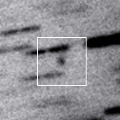
|
It stays observable at 18 mag from spring to summer. It is observable in excellent condition in the Southern Hemisphere. In the Northern Hemisphere, it stays unobservable for some more time.
Date(TT) R.A. (2000) Decl. Delta r Elong. m1 Best Time(A, h)
Apr. 15 22 6.25 -35 22.0 5.555 5.232 66 17.9 4:59 (287, 47)
Apr. 22 22 11.44 -35 0.3 5.482 5.249 71 17.9 5:04 (284, 52)
|
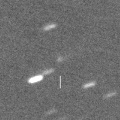
|
Now it is 17.9 mag (Mar. 30, Kunihiro Shima). It will be fainter than 18 mag in May.
Date(TT) R.A. (2000) Decl. Delta r Elong. m1 Best Time(A, h)
Apr. 15 15 1.06 -11 24.0 1.547 2.506 158 17.9 1:30 (180, 66)
Apr. 22 14 55.90 -11 14.9 1.540 2.527 165 17.9 0:57 (180, 66)
|
|
![]()
 2P/Encke
2P/Encke 71P/Clark
71P/Clark 73P/Schwassmann-Wachmann 3
73P/Schwassmann-Wachmann 3 29P/Schwassmann-Wachmann 1
29P/Schwassmann-Wachmann 1 65P/Gunn
65P/Gunn C/2016 R2 ( PanSTARRS )
C/2016 R2 ( PanSTARRS ) C/2015 O1 ( PanSTARRS )
C/2015 O1 ( PanSTARRS ) 213P/Van Ness
213P/Van Ness C/2015 VL62 ( Lemmon-Yeung-PanSTARRS )
C/2015 VL62 ( Lemmon-Yeung-PanSTARRS ) 315P/2013 V6 ( LONEOS )
315P/2013 V6 ( LONEOS ) C/2016 N4 ( MASTER )
C/2016 N4 ( MASTER ) 217P/LINEAR
217P/LINEAR C/2011 KP36 ( Spacewatch )
C/2011 KP36 ( Spacewatch ) 45P/Honda-Mrkos-Pajdusakova
45P/Honda-Mrkos-Pajdusakova C/2016 M1 ( PanSTARRS )
C/2016 M1 ( PanSTARRS ) C/2014 B1 ( Schwartz )
C/2014 B1 ( Schwartz ) 81P/Wild 2
81P/Wild 2 C/2016 B1 ( NEOWISE )
C/2016 B1 ( NEOWISE ) 74P/Smirnova-Chernykh
74P/Smirnova-Chernykh C/2013 X1 ( PanSTARRS )
C/2013 X1 ( PanSTARRS ) C/2014 W2 ( PanSTARRS )
C/2014 W2 ( PanSTARRS ) C/2014 OE4 ( PanSTARRS )
C/2014 OE4 ( PanSTARRS ) C/2016 A1 ( PanSTARRS )
C/2016 A1 ( PanSTARRS ) C/2017 D2 ( Barros )
C/2017 D2 ( Barros ) P/2000 S1 ( Skiff )
P/2000 S1 ( Skiff ) C/2014 R3 ( PanSTARRS )
C/2014 R3 ( PanSTARRS ) C/2013 V4 ( Catalina )
C/2013 V4 ( Catalina ) C/2017 E3 ( PanSTARRS )
C/2017 E3 ( PanSTARRS ) C/2015 TQ209 ( LINEAR )
C/2015 TQ209 ( LINEAR ) C/2016 VZ18 ( PanSTARRS )
C/2016 VZ18 ( PanSTARRS ) P/2015 TP200 ( LINEAR )
P/2015 TP200 ( LINEAR ) 43P/Wolf-Harrington
43P/Wolf-Harrington C/2017 D3 ( ATLAS )
C/2017 D3 ( ATLAS ) C/2016 T1 ( Matheny )
C/2016 T1 ( Matheny ) C/2016 N6 ( PanSTARRS )
C/2016 N6 ( PanSTARRS ) C/2015 X7 ( ATLAS )
C/2015 X7 ( ATLAS ) 144P/Kushida
144P/Kushida C/2013 C2 ( Tenagra )
C/2013 C2 ( Tenagra ) C/2015 H2 ( PanSTARRS )
C/2015 H2 ( PanSTARRS ) 94P/Russell 4
94P/Russell 4![]()









































